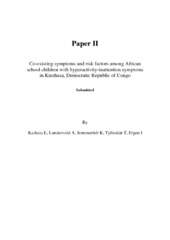Co-existing symptoms and risk factors among African school children with hyperactivity-inattention symptoms in Kinshasa, Democratic Republic of Congo
Kashala, Espérance; Lundervold, Astri Johansen; Sommerfelt, Kristian; Tylleskär, Thorkild; Elgen, Irene Bircow
Journal article
Submitted version
Permanent lenke
https://hdl.handle.net/1956/1123Utgivelsesdato
2006-03-08Metadata
Vis full innførselSamlinger
Originalversjon
https://doi.org/10.1007/s00787-006-0536-5Sammendrag
The aims of the study were to explore hyperactivity-inattention symptoms and co-existing symptoms of emotional and behavioural problems among African school children and their relationship with health status, socio-demographic factors, and school performance. Method: A case-control approach was used. The Strengths and Difficulties Questionnaire (SDQ) was used to explore the co-existing emotional and behavioural symptoms and a semi-structured interview with parents to explore the socio-demographic variables. The sample included 357 school children at the age of seven to nine years: 183 children were defined as cases, defined by abnormal scores on the SDQ hyperactivity-inattention scale (SDQ-HI) and 174 randomly selected children among those with normal scores on the SDQ-HI were defined as controls. No age and gender differences were noticed between the two groups. Results: A younger maternal age at childbirth, and poor school performances were more frequent among cases than controls. Three quarter of the hyperactive-inattentive children had co-existing symptoms according to SDQ, the most common being conduct problems. Conclusion: As in other cultures, co-existence of hyperactivity-inattention symptoms and emotional and behavioural problems was found in this African setting. Further validation of behavioural screening instruments in African children is called for.
